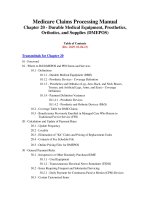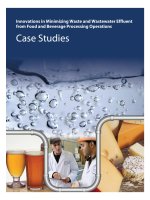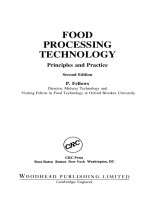Polyester fiber processing
Bạn đang xem bản rút gọn của tài liệu. Xem và tải ngay bản đầy đủ của tài liệu tại đây (764.71 KB, 43 trang )
Introduction:
Polyester are polymer made by a condensation reaction taking
place between small molecules, in which the linkage of the
molecules occurs through the formation of ester groups.
Polyester is commonly made by interaction of a dibasic acid with
a dihydric alcohol:
HOOC — X— COOH + HO — Y — OH—→ — OC — X — COO — Y —
OCO — X — COO — Y —OCO
Today, polyethylene terepthalate fibres are being made in many
countries, and modified forms of this fibre are also produced
POLYESTER FIBRES
The basic finishing processes for 100% PET polyester filament yarn
fabric may be arranged in the following three sequences:
1. Scour – heat-set – dye
2. Heat-set – scour – dye
3. Scour – dye – heat-set
Loom stains and other forms of contamination are difficult to
remove from cloth which has been heat-set, and it is preferable to
scour before heat-setting. Also, goods which have not been heat-
set before dyeing will tend to shirk during dyeing, and the dyed
goods will be subjected to high temperatures after dyeing. For
these reasons, sequence (1) is the most generally useful.
Processing
Sequence (2) eliminates a drying process and is
suitable for fabrics which are perfectly clean in the
loom state. It is however, rarely used for PET
polyester fabric except in the case of curtain nets.
If sequence (3) is used, some stiffening of the fabric is
likely to occur following heat-setting. The degree of
stiffening depends on the construction of the fabric
and on the tensions which are developed during
setting.
Scouring:
PET polyester fibres are supplied in a high state of
cleanliness, and it is generally unnecessary to scour
the material prior to dyeing. If, however, a batch of
fibre should become so dirty as to require scouring,
the bath may be set with:
Scouring recipe:
Water — 1000 parts
Soda ash — 2 parts
Detergent, such as textile soap,
Or lissapol C, D, NC, or ND — 1 parts
The temperature is rise to 70˚c for 15-30 minutes and, after
scouring, the goods should be rinsed thoroughly to eliminate all
traces of alkali. A small quantity of acetic acid may be added to the
final rinse.
PET polyester goods will often acquire and stains during
manufacture, including after-waxing agents applied to sized warp
yarns, loom stains and other forms of soiling. If goods are heat set
before removal of these stains, subsequent cleaning of the goods
will become difficult and perhaps impossible. It is preferable,
therefore to scour goods before heat-setting. A bath of the
following composition is commonly used:
Water — 1000 parts
Soda ash — 2-3 parts
Or caustic soda (flake)
Detergent, such as textile soap,
Lissapol C, D, NC or ND — 1-2 parts
Fabric of relatively open structure, such as voiles, marquisettes and
lenos may be scoured in a shallow which at temperatures below
60˚c.
Bleaching:
The natural white color of PET polyester fibers is usually satisfactory
for most purposes, and bleaching is unnecessary. When fabric are
to be finished white a slightly improved color may be obtained by
bleaching in a bath set with 1-3 parts of sodium chlorite per 1000
parts of water. Other common bleaching agents have little or no
effect on the color of PET polyester fibres.
The best results are obtained by making use of fluorescent
brightening agents. Those used with PET polyester fibres commonly
have the following characteristics:
1. A relatively high dyeing temperature is required. One result of
this is that they are virtually non-effective as additives in domestic
washing powders.
2. High wet fastness. This ensures little loss under normal washing
conditions, obviating the need for restoration of the white during
washing.
3. Light fastness is high enough for all apparel uses, and in most
cases is suitable also for furnishings curtains.
Fluorescent brightening agents are applied by the methods
used in dyeing with disperse dyes, i.e.
1. Application at the boil, without carrier.
2. Application at or near the boil, with carrier.
3. High temperature application (130˚c), without carrier.
4. Applications by pad-thermo fix techniques.
5. The method selected will depend upon the type of
machinery available, and the structure of the fabric. Most
fabrics may be handled on a beam-dyeing machine at or
above 100˚c, while a jig may be used for the more stable
woven fabrics. Rope processing in the winch is often used,
especially for warp knitted fabric.
6. Techniques recommended for obtaining a good white
finish on PET polyester and blends are outlined below.
100% PET polyester and PET polyester / Nylon Blends:
Warp-knitted Fabrics:
An excellent white is obtained by treating the heat-set fabric
with acidified sodium chlorite, followed by the application of
a fluorescent brightening agent at 130˚C.or 100˚C.With a
compatible carrier, on a beam-dyeing machine.
With most brightening agents, a good white can be obtained
by a single-bath method in which the fluorescent brightening
agent and compatible carrier are included in the sodium
chlorite liquor.
Weft-knitted Fabrics:
Weft-knitted fabric may be handled on the
winch, using similar techniques.
Woven Fabric:
The beam-dyeing machine is recommended
for bleaching woven fabrics. Alternatively, the
jig may be used, the concentration of chlorite
bleaching chemical being increase by some
20% to compensate for the shorter liquor.
PET polyester / Cellulosic Fibre Blends:
Chemical bleaching should be employed, especially when the cellulosic
component is cotton. For best results, fluorescent brightening agents
should also be applied for both components of the blend.
Several methods of chemical bleaching may be used, the choice depending
on the result required and the equipment available. Acidified sodium
chlorite provides most effective single stage bleach, and a high white is
obtained from a chlorite bleached followed by peroxide bleached.
A good result is also obtained from hypochlorite bleach followed by
alkaline hydrogen peroxide. Hypochlorite or peroxide used alone as a
single stage process will given a white suitable for many purposes, e.g. as
ground for subsequent dyeing. Processes excluding chlorite are generally
more suitable for color woven goods.
PET polyester / flax blends may be bleached according to these general
principles, but more intense treatment is required.
PET polyester / Wool Blends:
The PET polyester component cannot be bleached
with chlorine compounds in the presence of the wool
component. Chemical bleaching of PET polyester /
Wool blends is virtually restricted, therefore, to the
bleaching of the wool. Hydrogen peroxide is the
preferred agent, and bleaching is carried out after a
fluorescent brightening agent has been applied to
the PET polyester component. This corrects any
yellowing of the wool which may have occurred
during the application of the agent to the PET
polyester fibre.
Pre-Setting:
Unset PET polyester filament yarn will shrink when
allowed to relax in boiling water, commonly by some
7%. At 130˚., shrinkage is of the order of 10%.
If unset yarns in package form are subjected to any
process, such as dyeing, involving elevated
temperature, the shrinkage will bring about
consolidation of the package. In dyeing, this restricts
the even flow of dye liquor and causes unlevel
dyeing.
Heat-setting:
The purpose of heat-setting is to stabilizer the fabric to the effects of heat
treatment which it may receive in subsequent finishing processes, in
making-up, in use. The selection of heat-setting conditions is controlled,
therefore, by the intended end-use of the fabric and by the thermal
history of the yarns from which it is constructed.
For PET polyester fabrics, the heat setting temperature should be higher
than the temperatures which are to be used in pleating, embossing or
calendaring, so as to eliminate the possibility For PET polyester fabrics, the
heat setting temperature should be higher than the temperatures which
are to used in pleating, embossing or calendaring, so as to eliminate the
possibility of uncontrolled shrinkage in these processes. It should be
emphasized that the ability of PET polyester fiber to accept a permanent
set is not influenced by the temperature of prior heat-setting. In this
respect, PET polyester fibers differ from some other synthetic fibers.
Steam setting:
Pressure steaming is not recommended for
the setting of PET polyester fabrics, because
of variation between the inside and the
outside of the batch in the degrees of
shrinkage and restraint which are produced.
Hot-Air-setting:
A hot-air-setting is commonly used in heat-setting PET
polyester filament fabrics. The pin stenter is usually preferred
fro the setting of woven fabrics, but for fabrics in which a pin-
marked selvedge is unacceptable, the clip stenter may be
used in association with cylinder setting (see below).
There are difficulties associated with the control of warp
shrinkage in clip stenters. The clips tend to mark the
selvedges setting, and tight selvedges may be torn from the
body of the fabric. Local cooling at the selvedges is also more
severe in the clip than in the spin stenter, and may produce
marked unlevelness in subsequent dyeing.
Cylinder setting:
Cylinder of cylinder-blanket setting machines is used
principally in the stabilization of heavy industrial PET
polyester fabrics. Where stenters could not
withstand the high tensions developed in setting.
This method is also used with fabrics such
conjunction with stentering, it is also used to
produce the exceptionally uniform finish which is
required for PET polyester base fabrics which are to
receive a plastic coating.
Heat-setting Conditions:
PET polyester filament fabrics are commonly set by
exposure for 10-30 seconds in the hot zone of the
setting stenter. The extremes of this range
correspond with lightweight fabrics of less than 68
g/m2 (2 oz./sq.yd.2) and with heavy fabrics of up to
203 g/m2 (6 oz. /yd.2). The following table suggests
setting finishing of a wide range of PET polyester
filament fabrics:
Fabric
Fabric
Class
Class
Method
Method
Setting temp.
Setting temp.
(
(
°
°
C.)
C.)
Shrinkage warp
Shrinkage warp
Allowance (%)
Allowance (%)
weft
weft
1
1
Pin stenter
Pin stenter
210 - 220
210 - 220
3 - 5
3 - 5
3 - 5
3 - 5
2
2
Pin stenter
Pin stenter
200 - 210
200 - 210
3 - 5
3 - 5
3 - 5
3 - 5
3a
3a
Pin stenter
Pin stenter
150 - 160
150 - 160
0
0
0
0
3b
3b
Pin stenter
Pin stenter
150 - 200
150 - 200
0-5
0-5
0-5
0-5
4
4
Clip stenter plus
Clip stenter plus
150 - 160
150 - 160
0
0
0
0
5
5
Cylinder
Cylinder
200
200
Free
Free
Free
Free
Cylinder
Cylinder
210
210
10 approx.
10 approx.
Free (15
Free (15
approx.)
approx.)
Class 1 includes leno curtain fabrics and similar very open structures.
Class 2 includes the majority of PET polyester filament woven fabrics
(taffetas, twills, satins, etc.)
Class 3 includes color-woven fabrics. The majority of fabrics made from
high-temperature or carrier dyed yarns are stable to making-up and to
mild laundering conditions. Fabric properties such as handle and crease
recovery are, however, generally improved by the mild setting treatment
suggested for Class 3a. Fabrics made from yarns dyed by other methods or
which contain unset white yarns fall into Class 3b, and should be heat-set
at the highest temperature permitted by the sublimation of the dyestuffs
used.
Class 4 includes fabrics for which completely free shrinkage is not
permissible, but which must be finished free from pin or clip marks.
Class 5 includes fabrics in which shrinkage is desirable, such as sailcloth’s,
or which are too heavy for stenter processing.
Dyeing:
PET polyester fibres are hydrophobic, and dyeing of useful
depth are obtained by using those classes of dyestuffs which
are substantially insoluble in water. These include the
disperse dyestuffs, azoic dyestuffs (applied by a modified
technique), and a limited number of vat dyes.
Disperse dyestuffs provide build-up and color fastness that is
adequate for most purposes, and a wide range of colors is
available. Azoic dyestuffs produce a range of bright reds and
maroons, a black and a navy blue, all of which have good
fastness to sever washing, The usefulness of the azoic reds
and maroons is limited, however, by their tendency to be
dulled and to lose rubbing fastness after steam setting or heat
setting processes
Vat dyestuffs yield a limited range of shades ,one or two of which are very
bright , but they build up to only medium depths .PET polyester fibres
have high affinity for disperse dyestuffs but the rate of diffusion of these
dyestuffs in the fibre is relatively low. The rate of dyeing may be raised to
a commercially accept able level either by working at the boil in the
presence of an accelerating agent or carrier, or by dyeing under super
atmospheric pressure at temperatures in the region of 130˚C. The high
temperature dyeing method is preferable and should be used where
possible, in order to take advantage of the excellent leveling action
obtainable under these conditions. This technique also avoids the adverse
effect of certain carriers on the light fastness of some dyestuffs.
The full range of available disperse dyes can be applied at high
temperature; whereas some of the newer disperse dyes do not build up
well when dyed at the boil in the presence of a carrier.
Disperse and selected vat dyestuffs may also be applied to piece goods by a
pad-back technique, using dry heat at temperatures in the range 190-
215˚C.
Printing:
•
100% PET polyester woven Fabric
Fabrics woven from 100% PET polyester fibre yarn are
usually printed with disperse dyestuffs, although a
limited number of vat dyestuff may be used. The
disperse dye provide a wide range of bright and deep
shades, but the choice of individual dyestuffs is
governed not only by the projected end-use, but also
by the method to be used in fixing the color on to the
fibre.









